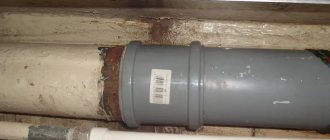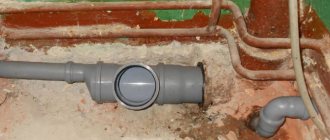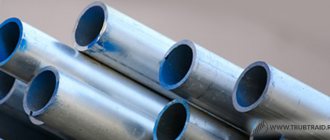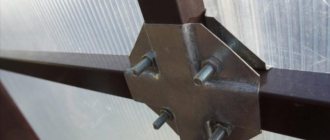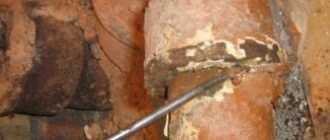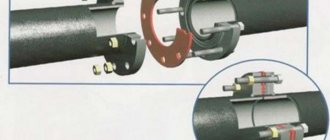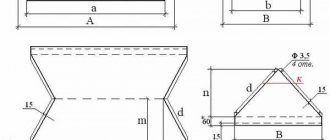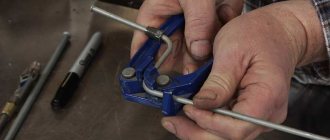The absence of problems during the operation of a cast iron pipeline directly depends on how correctly the connection of cast iron pipes is made. Today in stores you can find cast iron pipes with a socket (SME) or without it (SMU). The features of various connection methods will be the topic of this article.
Sealed pipe connection is the key to stable operation
When is such a connection required?
Certain sections of the iron sewer system are removed in a number of cases:
- Leak formation due to prolonged use or rupture of communications due to impact loads.
- Major renovation of the facility. All plumbing fixtures are replaced, but metal structures are left in some areas due to the difficulty of providing access to them or because they are in good condition.
- Organization of an autonomous wastewater disposal system on the site. They install plastic pipes from metal communications inside the house to a septic tank located at some distance.
- Updating the sewerage system. The goals are to facilitate maintenance, increase the rate of outflow of contaminated water, and the need to replace metal elements with rough internal walls with plastic counterparts with a smooth surface.
Violation of pipe integrity
Another reason that causes the need for replacement is the formation of cracks, fistulas, and fractures. If such defects are present, the system is considered worn out and requires immediate replacement.
Operating standards for cast iron sewers for apartment buildings are 25 years.
If replacement is necessary, repair work is carried out centrally - in all apartments within a certain time frame. Dismantling and installing sewer pipes in only one apartment causes a lot of inconvenience to neighbors. But as the experts are convinced, this will not have much impact on the functionality of the system and the efficiency of wastewater passage. The reason, as a rule, is the formation of congestion at the junctions of cast iron products with plastic parts.
Dimensions of cast iron and plastic pipes
The internal sewerage system of the overwhelming majority of individual houses and communal apartments is installed from two pipe sizes - 110 mm and 50 mm. A riser was installed from a large diameter pipe and a sewer pipeline was installed connecting it to the toilet. A 50 mm pipe is used to lay lines from kitchen sinks, sinks and bathtubs, showers to the central riser.
To understand the best way to connect a cast iron sewer pipe with a plastic one, it is useful to consider their dimensional parameters, the typical values of which are for:
Cast iron
It is worth noting that the dimensions of any metal pipes are specified by the nominal diameter DN, which is approximately equal to the diameter of their internal passage channel.
For pipe cast iron, this is an internal cross-section of 50 and 100 mm. To determine the external dimensions in a circle, the pipe wall thickness S must be added to these digital values. For a 50 mm pipe its standard value is 4 mm, for a 100 mm pipe it is 4.5 mm. As a result of elementary calculations, we obtain the outer diameters of the pipes 58 and 109 mm.
As for the dimensions of their socket outlets, they have a conical shape inside, which is optimally suited for joining by caulking. For a 50 mm pipe, the dimensions of the socket from the inside are 65 - 72 - 76 mm, for a 100 mm pipe - 118 - 123 - 127 mm. It should be noted that when indicating the dimensions of transitional shaped elements, the average values are indicated - 72 and 123 mm.
Plastic
For indoor sewage systems, a plastic pipe made of polyvinyl chloride (PVC) of gray color is widely used. Its dimensional parameters are set by the outer diameter, the typical values of which are 50 and 110 mm. When considering any methods of connecting them, the internal circumferential dimensions and wall thickness (can vary significantly for products with different classes of ring stiffness SN) do not play any role - all PVC connections are made externally to the pipe.
So, the main conclusion that can be drawn from the considered pipe dimensional parameters is that the outer diameters of a 110 mm PVC pipe and a 100 mm cast iron pipe are practically the same, their difference of 1 mm is not significant.
Why plastic is considered the best option
There are several options for replacing cast iron sewer pipes, including the same good old cast iron. Modern cast iron products are more technologically advanced, easy to install and almost as durable as those produced half a century ago. But in most cases, owners of houses and apartments choose plastic. There are several reasons:
- Smooth inner walls. This is the most valuable property for sewer pipelines. Deposits do not form on smooth surfaces, the permeability of the pipes is high, and their diameter almost does not decrease over time. Replacing cast iron sewer pipes with plastic ones solves the problem of frequent blockages. If the pipeline becomes clogged, it is easier to clean it.
- Lightness of the material. Plastic is tens of times lighter than cast iron, so any products made from it are easier to transport, carry, lift up stairs, and install. Often it is chosen precisely for these reasons.
- Easy to install and dismantle. To install a plastic pipeline, you do not have to buy complex, expensive equipment. It is much easier to install than cast iron. If necessary, the structure can also be easily disassembled. If you need to replace a damaged section, there will be no problems; you can do everything yourself.
- Tightness. Homeowners who have had to install cast iron pipes themselves know very well how difficult it is to achieve tight connections. There are no such difficulties with plastic products. Manufacturers produce not only the pipes themselves, but also additional elements that facilitate installation.
The junction of cast iron and plastic sewerage
A few words about the shortcomings of the material
Whatever advantages plastic has, it is not perfect. To make an informed decision, it is worth understanding its shortcomings well. The main one is poor resistance to high temperatures.
In many ways, the operating temperature range depends on the quality of the material and manufacturing technology. Polymers with good performance characteristics are not cheap, so when choosing, you should focus not only on prices, but also on technical indicators.
Plastic drainage may not withstand prolonged exposure to hot liquid. So, at a temperature of 60 degrees, the pipeline sometimes becomes deformed. A temperature of 90 degrees can seriously disrupt the operation of the system and will require repairs.
Manufacturers of plastic sewer pipes are well aware of the problems that consumers have, so they offer products with special coatings that reduce risks. They are somewhat more expensive than traditional ones, but they withstand high temperatures better, are soundproofed, and have high throughput.
Benefits of switching from cast iron to plastic
Polypropylene sanitary products have a number of operational advantages:
- withstand temperature changes;
- resistant to aggressive environments;
- deposits do not accumulate in them and blockages do not form, since the inner surface of the products is smooth;
- are light in weight;
- easy to install;
- affordable.
Fittings have a service life of up to 50 years.
We suggest ordering transitions from cast iron to plastic using the catalogue, contact us by phone. Orders are formed promptly, delivery is made throughout Moscow and Russia on favorable terms. All products are provided with quality certificates. The TERMA-MSK online store accepts retail and wholesale orders, offers convenient payment options and favorable prices for shaped fittings for the installation of internal sewerage.
Preparatory work
The first step is to carefully measure the area to be replaced in order to know the number of pipes and what diameter you need to buy. The diameter is also an important aspect, for example, when replacing an internal pipeline, pipes with a diameter of 50 mm are used, and when replacing a riser or a section coming from the toilet - 110 mm. In addition, you will also have to purchase a certain number of adapters, angles and other fittings.
Before starting work, prepare the material and tools:
- plastic pipe of the required diameter;
- a coupling that will be used to make the transition from cast iron to plastic;
- wooden or rubber mallet;
- grinder or hacksaw for metal.
It is advisable to complete the replacement of the sewer pipeline within 1 day.
Video: Installation of a transition from a cast iron sewer pipe to a plastic one.
Methods for connecting cast iron sewers to plastic ones
The method of installing old and new communications is chosen taking into account the condition of cast iron products. Evaluate their appearance. Determine whether there is a bell and how smooth the cut is. The degree of reliability of the end section is established.
Often, during prolonged use or due to exposure to intense loads, cracks appear, which is due to the fragility of the metal. In addition, the method of connecting plastic to cast iron is chosen depending on the availability of the necessary tools at the time of installation.
Connection with rubber gaskets
This joining option is used if the sewerage section is in good condition: there are no cracks, the inner walls are smooth. When defects appear inside the cast iron product, it will not be possible to ensure a tight fit of the rubber element.
Instructions:
The rubber cuff for connecting pipes must be selected according to size.
- Clean the drainage system in the area where the plastic pipe will be connected to the cast iron pipe. Removes layers of plaque and rust.
- The internal surfaces of metal and external walls of polymer pipes are treated with a sealing compound.
- Insert the rubber gasket into the socket of the metal product. On the other hand, a polymer pipe is inserted into it.
- The joints are additionally treated with sealant.
The advantage of this method of connecting the sewerage system is ease of installation. If necessary, the connection is easy to disassemble. After this, the surfaces are cleaned of sealant and reinstalled.
If you are replacing a section of the system without a bell, you should follow other instructions:
- The edges of the metal product are trimmed with a grinder.
- The outer walls of the cast iron pipe and the inner surface of the rubber cuff are treated with sealant. These elements are connected by first installing a seal.
- A plastic adapter is connected to the other side of the cuff.
- All joints are sealed with silicone compound.
- A PVC pipeline is connected to the adapter.
Flange connection
It is more difficult to implement this method on your own, since it requires experience and the availability of special tools and necessary parts. In addition, this option is chosen for large diameter plastic and metal pipes.
The advantages of the flange joining method are strength, high reliability, and the possibility of dismantling.
To work, you will need a mallet (with a rubber nozzle, since cast iron is damaged under the influence of shock loads), a grinder, and a welding machine.
For installation of structures:
- Cut off communications.
- The edge is cleaned of burrs.
- A flange is welded to the prepared metal pipe.
- A crimp sleeve is applied to the PVC pipe. There must be a gasket between the flange connection elements.
- Tighten the crimp coupling and the welded part of the flange using bolts.
The tightness of the connection is ensured by a rubber gasket and a tight fit of the parts. The intensity of the clamping of the flange parts varies depending on the tightening force of the bolts.
If they are tightened too loosely, a leak will occur during operation of the sewer system. It is also not advisable to tighten the bolts too much, since the risk of stripping the threads increases.
Connection with fittings
The role of adapters in the sewerage system cannot be overestimated. Without their help, not a single repair of plumbing pipes or construction of a new line can be completed. Fittings are of particular value in cases where it is necessary to make a transition from pipes of one diameter to pipes of another - larger or smaller. Adapters are indispensable when carrying out repair work indoors, when it is not possible to change the entire sewer system, and only a certain section of it has to be changed.
We recommend: The principle of water purification with a reverse osmosis filter
Very often, the material of pipes in common building networks does not match the material of the pipes installed in the apartment. The most common situation is the following: the common sewer riser is made of cast iron, and the apartment owner plans to install plastic in his bathroom. In such cases, adapters come to the rescue, which are capable of connecting pipelines of different materials into a single network and at the same time ensuring a reliable and tight connection.
To install products made of cast iron and plastic, a special element with a thread at one end is used. It's called a press fitting. The other side of such a product is smooth-walled. The bell is located here.
It is recommended to use this joining option if there is no widening at the end of the cast iron pipe. Then it can only be connected to a plastic structure using a press fitting.
Instructions:
Connecting a plastic pipe with metal fittings.
- A chamfer is made at the free end of the cast iron pipe. This measure facilitates easy insertion of the product into the connecting element.
- Thread is cut. You need to make no more than 5.5 turns.
- The end section is protected with FUM tape, sealant or tow. You need to cover the entire thread.
- Install the fitting. It is screwed on, being careful not to damage the sealing material, otherwise the reliability of the connection will decrease.
- On the other hand, a PVC pipe is connected to the fitting. It is inserted into the socket. To increase the reliability of the connection, an O-ring is used.
Given the difference between the thermal expansion of plastic and cast iron, the use of polymer fittings is not recommended. It is better to use metal elements.
Embossing with linen winding
This option has been used for a long time. It was used before the advent of elastic bands and sealing compounds. The advantages of this method are ease of installation and low price of consumables.
It is used to connect a cast iron system with a socket at the free end and a PVC pipe with a smooth end.
Instructions for performing the work:
Caulking sewer pipe connections with flax.
- Flax fibers are wound onto a PVC pipe. The material should cover the end section. The winding consists of several layers.
- A PVC pipe is inserted into a cast iron product.
- Use a flat screwdriver to seal the seam. You can also use a narrow spatula for this. The process is called coining.
- The joint is sealed with a solution based on cement, PVA glue and water.
The mixture will dry in 24 hours. After this, the sewerage system can be operated.
Silicone sealing
This method is the easiest. To implement it, you only need a sealant. The silicone compound is used provided that the cast iron pipe has a socket.
When joining smooth-walled communications, the sealant will not withstand the intense impact of liquid during the movement of drains. As a result, a leak forms.
In addition, silicone sealing is only used if the pipeline installation is done correctly. It should be located at a fairly large angle. Then, when passing through the junction of cast iron and plastic pipes, the likelihood of a leak is significantly reduced. The width of the gap is also taken into account: silicone is used if the gap does not exceed 2 mm.
Instructions:
Connecting sewer pipes using silicone sealant.
- Cast iron is cleaned of rust and dirt.
- The metal surface is dried. A hair dryer is used for this.
- The PVC pipe is covered with plumbing thread in the area that will be inserted into the socket of the cast iron product, at a distance of 8-10 cm from the edge. This measure will allow the connection to be sealed.
- A PVC pipe is inserted into the widening of the metal structure.
- The joint is protected with silicone.
To ensure that the sealing compound fills the entire gap, including the space at a significant depth, a construction gun is used. Silicone sets quickly. After 3-5 hours, you can begin operating the sewerage system. However, it is recommended to let the material dry completely. It is better to supply water 1-2 days after completion of installation.
Installing a plastic adapter with a seal
If there is no expansion at the end of the sewer pipes, the connection can be made using a plastic adapter with a seal.
This connection option is not characterized by a high enough degree of reliability, but it is quite acceptable.
At the installation stage, the end of the pipe is cut straight using a grinder, after which a rubber ring and a plumbing sleeve are put on.
The joints are carefully coated with silicone sealant. Then a plastic adapter with an installed ring is inserted and the socket part of the polymer pipe is put on.
Smooth pipe connection
In addition to cast iron pipes with a socket, smooth structures are also used to create pipeline systems. Various devices are used to connect them. Among them there are couplings, saddles, crosses, elbows, etc. Which one to use will depend on the diameter of the pipe and the type of connection.
The most common fitting is the coupling. It comes in three main types:
- If pipes of the same diameter are connected, then a coupling in the form of a cylinder is used. There is a thread inside this fitting.
- To connect pipes with different diameters, a device in the form of two cylinders is used. This coupling is also equipped with an internal thread.
- The heating system uses a futorka. Such a coupling is the same cylinder, only with threads on both the internal and external surfaces.
The connection process using a coupling is quite simple. First you need to mark them to see how much each pipe should fit into the coupling (you need to calculate so that the ends meet exactly in the middle). Then both pipes are simply inserted into the coupling. For sealing, you can use a special sealant.
But the pipeline may run at an angle or include branches. Other devices are used for this. For example, connecting cast iron sewer pipes at an angle is carried out using bends. They are a piece of pipe bent at a certain angle (10, 15, 30, 60 and 90 degrees).
In addition, there are other devices for connecting pipes. For example:
- Tee. With its help, you can connect three pipes at once into a single system. As a rule, such a connection is necessary in places where the sewerage system branches.
- Cross. A design that helps connect four pipes at once.
- Saddle. This device allows you to connect a smaller diameter pipe to the main line (for example, from a free-standing plumbing fixture).
All these devices may have sockets or straight sections at the ends. To seal the joint, various sealants or tow are used.
We recommend: Sewerage in a private house - diagram, depth of laying sewer pipes with your own hands
Embossed with flax
The technology was originally used to connect cast iron pipelines. This option is also used when it is necessary to ensure a transition from cast iron to plastic 100 mm (sewer). Typically the riser has this diameter, but other options are possible. The plastic pipe is wound at the end with plumbing flax, so that it remains possible to insert it into the socket. Flax is wound 3-4 cm, no more. After this, the winding is sealed along its entire diameter with a thin metal strip - a long screwdriver, a ruler, a piece of wire, etc. You must act carefully so as not to accidentally break a piece of cast iron from the socket. Then they make up a cement mortar with the addition of PVA glue (polymer cement composition) and fill the gap of the socket over the winding so that no gaps remain.
Flange connection
The detachable connection is used when working with large-diameter pipelines, where it is difficult to cut threads using threaded couplings.
If necessary, this connection option can be disassembled for repairs.
After evenly cutting the cast iron pipe with a grinder, the welding area is carefully cleaned of burrs and nicks. A flange is welded to the resulting pipe.
To connect a plastic pipe, a special crimp coupling is put on, and the flange part is bolted to the cast iron flange. A sealant should be installed between the flanges.
Combining several methods
If there is insufficient density between the connected pipelines of 100, 110 and 50 mm from different materials, it is advisable to use different methods simultaneously.
Using a rubber seal and silicone sealant with installing a flexible adapter is a very easy option to implement.
With this method, a plastic pipe is inserted into the socket part, and the space is filled with sealant. Equally widespread is the combination of the caulking method with the use of sealant and partial filling of tow.
Additional seal for repairing socket joints
Special attention should be paid to repair devices for cast iron socket pipelines. In emergency cases, when socket joints leak, to repair them, an additional sealant is used for socket joints of cast iron pipes. The dz additional seal (photo) consists of two split rings placed on the pipe, a rubber gasket and long tightening bolts. The additional seal is applied to the joint where the leak has formed, the rings are tightened using bolts, the gasket is compressed and seals the leak.
Advantages of an additional seal for socket joints of cast iron pipes dz:
- the ability to eliminate leaks on existing pipelines without reducing pressure;
- the design of the additional compactor allows work to be carried out regardless of weather conditions, in cramped places, in flooded trenches;
- quick and easy installation, reliability;
- can be used for water supply and sewerage networks;
- low cost.
Additional seals can be used not only when repairing joints, but also during the initial installation of cast iron pipelines.
[my_custom_ad_shortcode3]
If the bell is damaged
If the bell is damaged, then the methods described above are not suitable. When performing installation, you will need to purchase an additional part - an adapter that allows the transition from a cast iron pipe to a plastic one. The procedure for connecting pipeline elements is as follows:
- the damaged socket is carefully cut off with an angle grinder;
- the edges are processed;
- a rubber sealing ring and a rubber cuff are put on the prepared part of the cast iron pipe;
- the edge of the rubber part is lubricated with sealant, then a plastic adapter is put on;
- lubricate the adapter pipe with sealant and install another rubber O-ring;
- After this, you can insert the plastic part into the adapter.
Dismantling an old pipe
The cast iron pipeline must be dismantled very carefully to prevent chips or cracks.
In the past, joints were often sealed using cement and tow, so it may take a lot of effort to release the joints.
It is necessary to disconnect the pipes by twisting, and in no case by rocking. If you are not sure that the socket of a cast iron pipe can be released without damage, it is better to carefully cut it with a grinder.
It is important! You should not try to break off a cut cast iron pipe. Most likely the break will be uneven and you will have to cut again. It is better to work with the grinder a little longer and cut the cast iron product completely.
Connecting sewer pipes with glue
The strength of this joining method is based on the mutual penetration of polymers at the molecular level. First of all, you should purchase a special glue that is used to coat the edges of the pipes. After that:
- the surfaces to be bonded are cleaned of dirt, sanded and degreased;
- the prepared edges are greased with glue;
- the ends of the pipes are placed inside each other;
- In order to ensure tightness, the joint is coated.
It is necessary to start connecting the pipeline elements immediately after applying the adhesive composition, since it quickly loses its properties in air. Bonding must be completed within 90 seconds.
What to consider when choosing a method: which is better?
The choice of technology for connecting pipelines made of different materials directly depends on the integrity and general condition of the cast iron socket.
To insert into a cast iron sewer pipeline and switch from plastic to cast iron or vice versa, several methods can be successfully used, but the use of a fitting in the form of a compensating pipe is considered optimal.
Such a plumbing fixture quite easily compensates for deformation and failure of the sewer network as a result of linear thermal expansion or contraction, and also helps to give the drainage areas the required level of inclination.
It is advisable to use pipes along with corrugated pipes if it is necessary to adjust the height of the cross to create an optimal angle for installing the toilet.
Types of rubber cuffs for connections
When carrying out renovations in houses of old buildings, it often becomes necessary to make a drain from some modern plumbing fixture into a cast iron sewer riser.
For ease of work, there are several types of PVC adapters; using them, you can lay a pipeline of any configuration.
Connection cuffs are sold in specialized stores
Types of PVC adapters:
- Transition coupling.
- Crosspiece;
- Tee;
- Bypass;
- Compensator.
But when installing pipes, you often have to connect pipes from different materials. Often you need to switch, for example, from a cast iron to a plastic pipe. Then you will need a rubber insert (cuff) for the adapter.
Types of rubber cuffs:
- Cuff of internal transition. It is usually inserted into the socket of a cast iron pipe. Then a plastic pipe of the required diameter is inserted.
- Outer cuff. Its cross-section should correspond to the diameter of the cast iron socket, then there will be no need to use sealant.
If there is no socket in the sewer, an external adapter will be required. You can use it to make a connection. Then it will be possible to continue installing the rest of the plastic sewer system. Plumbing elements, without which it is practically impossible to lay communications, are adapters for water supply, heating and sewerage pipes. All problems arising during the repair process regarding the connection and routing of pipes of different diameters can be solved practically without restrictions with the help of PVC adapters.
GOSTs and standards
The production and dimensions of cast iron sewer pipes are regulated by GOST 6942-98.
For plastic pipes, there are many GOSTs and SNiPs that regulate their individual characteristics.
Each type of polymer, depending on the scope of application (sewage, heating or water supply), has its own GOST standards.
For example, the characteristics and dimensions of plastic pipe products intended for cold and hot water supply and heating systems in buildings for various purposes are regulated by GOST R 52134-2003.
Noise insulation and causes
Of course, pipes made of polyvinyl chloride and polypropylene are much better than cast iron. They will last longer, have an aesthetic appearance and are much cheaper. However, they have one significant drawback. It's noise. At first, even experienced specialists didn’t know how to deal with this. But today, as soon as the pipes are installed, they begin to deal with noise and sound insulation. It's not at all difficult to do this yourself. Therefore, do not be afraid! Having done this work, you will forget what the noise from the pipe is.
installation of a plastic pipe with a check valve and connection to a cast iron riser pipe
There is no one way to achieve the soundproofing effect yet. Therefore, different ones are used, depending on the design, acoustic features and the availability of certain materials.
Why do cast iron pipes make no sound, but modern plastic pipes are so noisy? After special research, several causes of extraneous sounds from the riser were revealed. Among them are:
- impact sounds occur when the contents hit the walls of the pipes, making noise;
- atmospheric phenomena occur when the wind howls, rain or, especially, hail;
- resonant manifestations appear when extraneous noise is transmitted;
- vibration sounds are transmitted from the entire structure, the movement of underground transport, and so on.
The pipe itself, due to its shape, suggests the possibility of perceiving and transmitting sounds of various natures. But the material from which it is made is also important. Those cast iron risers that still stand in old buildings do not make noise precisely for this reason. After all, it is not completely metal. It is an alloy that consists of different grains that differ in composition and properties. This ensures sound absorption, as the grains rub against each other and reduce vibration.
cutting old cast iron pipe
In addition, such pipes are covered with plaque from the inside, which in itself plays the role of an excellent sound insulator, despite the fact that the movement of wastewater slows down.
Soundproofing installation
The main task of sound insulation in an apartment is to reduce noise to a minimum and, if possible, dampen vibration.
The ideal option is to purchase special noise-absorbing pipes. Some companies produce and install such risers. They contain plastic with the addition of mineral powder. This provides a material that has similar properties to cast iron. However, these pipes are expensive and may not be affordable for many. In addition, their service life, as a rule, does not exceed twenty years.
Therefore, plastic pipes are mainly used for replacement, followed by insulation from noise and sound.
They are isolated from the walls using damper clamps, and from the ceilings - with polyurethane foam boards.
In order to eliminate unpleasant gurgling in pipes, polyurethane foam or polystyrene foam is used. Both the riser and the wiring are turned around so that sound is not transmitted.
Replacing a sewer riser is a difficult job, but even a beginner can handle it. However, if you are not confident in your abilities or the pipes in the house are very rusty, then it is better to resort to the help of specialists and entrust the work to them, since otherwise you risk flooding both your apartment and the neighbors below.
Diameter standards
For domestic domestic sewerage, cast iron pipes with an internal cross-section of 50 mm (DN) and 100 mm (DN) are used.
The dimensions of external sewerage are determined by SNiP standards. In intra-block networks, a diameter of 150 mm is used, in street networks - 200, 250 mm.
Polypropylene products are produced in accordance with GOST 26996-86. The standard has not established a specific size for the sewer sector. But in practice, the following diameters of sewer plastic pipes have developed: 32, 40, 50 and 110 mm.
For polyethylene pipes, working diameters - 40, 50, 90 and 110 mm - were determined by GOST 22689.2-89.
For PVC products, the cross-section of sewer products is regulated by GOST 51613-2000. Its requirements: PVC pipes must have a Ø from 10 to 315 mm.
In order to make drainage, lay external sewerage, septic tank pipes, you will need products with a cross-section of 110-200 mm.
Step-by-step technique for connecting pipes with your own hands
The technology for performing the work includes the following stages:
- Preparatory stage.
- Selection of tools and materials.
- Dismantling part of the old pipeline.
- Preparing two parts of pipes for connection.
- The operation of joining parts.
- Required tools and materials
At the first stage, the location of the connection is determined and the method of its implementation is chosen. Make the necessary measurements and determine the need for materials.
Required tools and materials
Polymer pipes are purchased in the appropriate size. To connect the toilet to the crosspiece, you will need elements with a diameter of 110 mm; for laying pipes to a sink or bathtub, the best option would be plastic with a diameter of 50 mm.
In accordance with the project, the necessary connecting materials are purchased: seal, fitting, sealant, etc.
Select the necessary tool. It may include:
- a set for dismantling the cast iron part - a hacksaw or grinder, a mallet, possibly with a rubber pad;
- screwdriver;
- spanners.
To cut the thread you will need a thread cutter.
For plastic joints you will need either a hand press or a welding machine - an iron.
Features and subtleties of work
Understanding the technology of how to connect a cast iron pipe to a plastic one, you should pay attention to the following subtleties:
Since cast iron pipes are quite fragile, when working with them you should use only a wooden or rubber hammer, so that in case of a careless blow you do not break off a piece of cast iron and clog the lumen of the channel. Although working with a grinder with cast iron pipes is much faster and more convenient, an ordinary hacksaw for metal will still do. The quality of work will be similar, however, much more time will be required. When installing plastic pipes, we must not forget about inspection hatches
They may be needed in emergency situations so as not to waste time and money and not to cut the plastic pipe for diagnosis and repair.
Connecting a toilet to a cast iron pipe
If your toilet's drainage system is made of old cast-iron pipes, then when purchasing a new toilet, find out how to connect it. Here everything will depend on the direction of the toilet outlet (that part of the structure from where wastewater enters the sewerage system).
If your sewer system has not been changed since the day the house was built, then the pipe may stick out from the floor, at a decent distance from the wall (unless it is a common riser going to the upper floors). For this case, you need to buy a toilet with a vertical outlet (at the bottom of the structure). A toilet with a vertical outlet is very easy to connect; just insert it into the pipe socket.
A toilet with a horizontal outlet is also connected. Such designs can often be found on imported products. To connect such a toilet, you need to insert the outlet into the socket. It is better to seal the joint area with sealant or tow. This way, you will prevent leaks and prevent the appearance of an unpleasant odor.
The more common option is with an oblique release. To connect such a toilet to a cast iron pipe, you can use a bend with the desired angle. It is inserted into the pipe, and the toilet outlet is connected to the outlet. It is also advisable to seal the connection point.
But with all these connection options, it is necessary to connect the toilet directly to the pipe. This does not allow you to install the plumbing fixture in a place convenient for you. The installation location will depend on the location of the sewer pipe. That is why a special device, a corrugation, is used to connect the toilet to the sewage system.
We recommend: How to eliminate unpleasant smell from sewerage in the bathroom and toilet
The plastic corrugation easily fits onto the toilet outlet (if it is oblique or horizontal), and the other end is inserted into the pipe socket. This method allows you to install plumbing fixtures in any place convenient for you.
The corrugation is easy to stretch to the required distance and rotate in any planes and at any angle. In this case, the connection point may not be sealed.
The corrugation is equipped with a rubber nozzle, which fits tightly into the pipe socket and prevents moisture and odors from leaking out.
We assemble a sewerage system for a house or apartment
The process of connecting pipes
Before you understand how to connect sewer pipes, you should understand the principle of assembling the entire sewer system.
So, all work should begin with creating a drawing on which you should depict your future system. Take a piece of paper and draw on it schematically all the plumbing fixtures that need to be connected to the sewer (sink, toilet, shower or bathtub, etc.).
Typical sewerage diagram
Then connect them with lines to the main sewer riser. Every line is a pipe
The pipes will be connected to each other using fittings. Please note that sewer pipes in a house usually have only two types: with a diameter of 50 and 110 mm. Fifty millimeter ones are designed to drain waste from sinks, sinks, bathtubs and showers, as well as from washing machines and dishwashers
If there are too many plumbing fixtures on one line, then it is better to increase its diameter to 110 mm, otherwise you will often have problems with blockages. But the toilet is connected only through a pipe with a diameter of 110 mm, while the connection itself to the plumbing fixture is usually made using a flexible corrugation, which is inserted into the sewer pipe.
Connecting the toilet
Having figured out what elements your sewer system consists of, you can go to the store. Since it is almost impossible to damage sewer pipes when working with them, you should not purchase components in excess. The main thing is not to forget that each pipe at one end has an extension into which another pipe will be inserted. If you cut a long pipe with a hacksaw (the cut must be strictly perpendicular) into two parts, then the second element will not have such an expansion, and to connect it to another pipe or fitting you will first need to install a coupling. In this case, the cost of different sets of pipes (one with a coupling or two short ones) will be approximately the same.
Pipe replacement
- The first in the sewerage system will be a turning fitting, to which you will connect a flexible hose of a plumbing fixture (siphon) on one side, and a pipe on the other. You can, of course, do without this fitting by connecting the siphon directly to the pipe, but in this case, if the joint is not airtight, there is a possibility of the joint leaking.
- When inserting a pipe into a fitting (or vice versa), be sure to observe two conditions:
- a rubber gasket must be placed at the joint (it is sold as a set);
- the pipe must fit into the fitting (or into another pipe) to its full possible depth.
Sewage scheme in the apartment
- Next, in places where other plumbing fixtures are connected to this pipe, tee fittings are installed. If you need to connect pipes of different diameters, use a special adapter fitting.
- When assembling the sewer, do not forget about creating the necessary slope of the pipes, otherwise your system will not provide liquid drainage.
- Assembling the system must move from the plumbing fixtures to the main riser so that the flow of water is not interfered with by the joints.
Sewage installation rules
When replacing the sewerage system for an apartment, it is important to carry out all work in accordance with the rules, since the quality and durability of the updated system depends on this.
These implementation approaches must meet the following requirements:
- vertical fall - at least 3% (3 cm per 1 meter of length);
- the correct diameter is selected, which is recommended to increase it when there are more than three turns on the route.
- toilets are not connected to the same line with other plumbing fixtures, but are connected directly to the riser;
- brackets for fastening pipes must allow their thermal movements.
Of course, larger diameter pipes provide better drainage and are less likely to clog, but the thicker they are, the more difficult they are to hide. However, it is worth increasing the diameter of the approach to the sink from 40 to 50 mm - this will not interfere with the work and improves the drainage of wastewater. If several appliances are connected to one approach, a larger wastewater flow must be taken into account, however in apartments and houses there is usually no need to use approaches with a diameter of more than 70 mm.
In any case, before starting work, it is necessary to draw up a clear and competent project for the work and invite experienced specialists to implement it. And only in this case you are guaranteed to be able to complete all the work at a high quality level, and you will not have to worry about choosing the correct method for connecting plastic and cast iron pipelines. This means that repairing and replacing the sewer system in the house will ensure durability and long service life.
Requirements for sewer pipe joints and connection angles
When creating a sewer system yourself, you should remember the rules for laying the pipeline. It is laid at a slight slope. This is necessary to prevent water from stagnating in the system. The slope must be at least 2 cm for each meter laid. The correct installation of pipes is checked by level.
Installed sewerage system in the floor on a slope
The weak point when laying a sewer system is the joints. Therefore, their sealing is of particular importance. After completing the assembly of the structure, the system is checked for leaks. To do this, the drain is completely filled with water. During testing, temporary plugs are placed in the revision. There shouldn't be any leakage.
Difficulties when connecting pipes made of different materials
The different physical and operational properties of cast iron and plastic cause the main difficulties when connecting two sections of the pipeline.
Cast iron is a fairly brittle metal and requires careful handling during operation. If, when dismantling old sewer pipes, it is permissible to use a hammer, sledgehammer and brute physical force, then when transferring a fragment of a pipeline from cast iron to plastic, you have to carefully cut the pipe with a grinder and clean the chamfer from rust and dirt.
Plastic also imposes certain restrictions on the work of a plumber. It is necessary to take into account the coefficient of thermal expansion of polymer pipes if we are talking about replacement in an area near a kitchen sink or bathtub.
The third point that determines the complexity and responsibility of the task is the difference in the diameters of the connected pipes. It is not always possible to find products that allow you to make a strong connection into a socket by placing a pipe of a smaller cross-section into a larger one. You have to buy additional adapters, expansion joints, fittings, as well as sealants, FUM tape and other materials in order to achieve the necessary sealing of the joint.
Important! These difficulties do not mean that it is impossible to connect a cast iron pipe to a plastic one. You can use different connection methods based on a specific situation, as well as use a combination of materials, and get excellent results at minimal cost.
Application of cold welding
If the pipe is damaged in places where it is impossible to use a clamp or coupling, cold welding should be used. This technology involves mixing several substances without heating, when combined, chemical reactions occur with the subsequent formation of a working polymer mixture.
Cold welding consists of epoxy resin and filler (hardener). For this reason, the adhesive composition has:
- high adhesive qualities;
- plastic;
- quick hardening (the solution must be used immediately after preparation);
- excellent mechanical characteristics.
Sealing cracks and holes in the sewer system involves performing the following actions:
- cleaning the surface from rust and paint with sandpaper;
- preparing the working solution (you should get a homogeneous mass);
- applying the mixture with a spatula around the damaged area (the first layer is laid as carefully as possible);
- coating a crack or hole with a composition;
- grinding hardened material;
- degreasing the surface;
- applying a second layer of polymer substance.
If a leak appears in the damaged area, the plastic substance is rubbed in until it hardens. At the polymerization stage, the material is given the desired shape. This is done with a hand wearing a rubber glove.
To speed up the hardening process of cold welding, use a construction hair dryer (especially when repair work is carried out in the cold season). After using a hairdryer, the polymer is pressed onto the surface.
Most cold welding manufacturers produce two-component products. The first tube contains epoxy resin, which is mixed with a plasticizer and additional filler. The second tube contains a material that acts as a hardener. First, the contents of the first tube are applied to the damaged surface, and then the second.
The main advantage of cold welding is the ability to carry out quick repairs without shutting down the sewer system.
Common mistakes: how to avoid problems
Quite often, rubber seals are inserted into the socket part of the pipe without proper preparation of its internal part, using force.
In this case, a violation of the integrity of the seal may well cause a loss of tightness of the completed connection, which will provoke a leak in the areas where the elements are joined.
Also, the reason for insufficient tightness and frequent emergency situations as a result of stagnation of water or blockage is the failure to maintain a sufficient slope of drainage from plumbing fixtures towards the sewer riser.
Among other things, when performing installation work, it is strongly recommended to use lubricant or insulation when joining, as well as strictly control the tightening force of all threaded connections.
